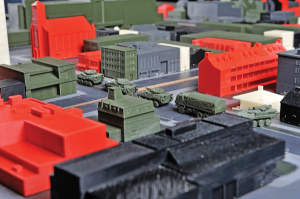Make me a Tank: 3d printing the future of training
By Lookout on Oct 26, 2015 with Comments 0

Major Tom Batty, officer commanding of the Army Learning Support Centre (ALSC), 5th Division Support Group Gagetown, picks up Fredericton’s City Hall to show off the detail in the hands of the clock face in the tower, and then sets the building back in place on its foundation.
Then he picks up the Justice Building across the street and slowly turns it on its side to show the level of detail in the brickwork over the front door.
Next he lines up a convoy of Light Armoured Vehicles (LAVs) and Leopard 2 tanks.
It is not superhuman strength that lets Maj Batty accomplish these feats – but rather feats of human ingenuity working in combination with modern technology.
The entire model of downtown Fredericton was built in Gagetown using innovative 3D printers, and sits on a plywood board that is 2m x 3m square.
This tiny town site plays an important role in helping Canadian soldiers learn about modern urban warfare, such as training in positioning troops and vehicles effectively in an urban core.
Instead of the past practice of conducting training exercises in the actual downtown core, scenarios can now be replicated accurately using the model in a so-called “cloth model” exercise.
A “cloth model” exercise is a war game event conducted on a table, on the ground, or on paper to practice particular maneuvers, battles or missions.
The 3D models enhance those tactical discussions and have the added geometric advantage of being able to build accurate scale models of the environments in which soldiers train.
These 3D printers are among the most innovative workhorses and are currently at work 24/7 to produce tiny replicas of vehicles, firearms and training aids on an “as-needed” basis, processing orders submitted from various schools, training centres and units within the Canadian Army.
The manageable size of the tiny models allows soldiers to handle the parts and become familiar with connectivity and part placement on a small scale.
In a real-life scenario, they will have an advantage on exactly what parts are needed, and will already be aware of some of the challenges they are may encounter in the field.
After the initial investment in the printers, the operating costs and materials are the only additional expenses required.
By transforming DND into a more efficient and effective organization through the innovative use of technology, all branches of the CAF will be better positioned to meet their future missions, including humanitarian assistance, combat, and peace support at home in Canada, within North America and around the world.
Re-printed courtesy of the
Maple Leaf
Filed Under: Top Stories
About the Author:





